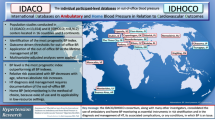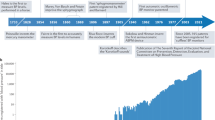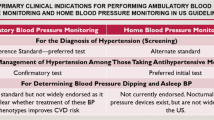Abstract
This article reviews the current literature regarding the role of home measurement of blood pressure (BP) in the management of hypertension. Subjects with hypertension can use simple automated devices to measure their own BP at home. The results can be accurate and reliable, and because multiple readings allow a mean value to be calculated, a better estimate of the underlying BP level is obtained. Home measurement of BP gives results which are equivalent to the accepted ‘gold standard’ measure of ambulatory BP values, whilst using a simpler and much less expensive technique which is therefore more widely available. Both methods are better than conventional office measurements in identifying the ‘true’ or underlying mean BP level and identifying falsely raised levels or ‘white coat hypertension’. White coat hypertension confounds the treatment of hypertension, but may not be entirely harmless. Ambulatory BP is a better predictor of cardiovascular prognosis than clinic BP. The use of home BP measurement as an equivalent, feasible, and (apparently) more cost-effective technique to measure BP in hypertension, should enable groups of patients with a poorer prognosis to be identified and their treatment adjusted in order to improve their prognosis.
This is a preview of subscription content, access via your institution
Access options
Subscribe to this journal
Receive 12 digital issues and online access to articles
$119.00 per year
only $9.92 per issue
Buy this article
- Purchase on Springer Link
- Instant access to full article PDF
Prices may be subject to local taxes which are calculated during checkout
Similar content being viewed by others
References
Chalmers J WHO-ISH Guidelines Committee. Committee, World Health Organisation—International Society of Hypertension Guidelines for the management of hypertension J Hypertens 1999; 17: 151–185
Frijling BD et al. Blood pressure control in treated hypertensivepatients: clinical performance of general practitioners BJGP 2001; 51: 9–14
Stergiou GS et al. White coat effect detected using self-monitoring of blood pressure at home: comparison with ambulatory blood pressure Am J Hypertens 1998; 11: 820–827
Appel L, Stason W . Ambulatory blood pressure monitoring and blood pressure self-measurement in the diagnosis and management of hypertension Ann Intern Med 1993; 118: 867–882
Yarows SA et al. Home blood pressure monitoring Arch Intern Med 2000; 160: 1251–1257
EBMWG. Users guide to the medical literature JAMA 1994; 271: 389–391
Osman A et al. Users guide to the medical literature JAMA 1994; 272: 1367–1371
Sackett D . Evidence-Based Medicine: how to practice and teach EBM Churchill Livingstone 1997
Greenhalgh T . How to Read a Paper BMJ Publishing Group 1997
Ramsay L et al. British Hypertension Society guidelines for hypertension management 1999: summary BMJ 1999; 319: 630–635
Anonymous . American Society of Hypertension releases guidelines on home and ambulatory blood pressure monitoring Am Family Physic 1996; 54: 1390
Prasad N, Isles C . Ambulatory blood pressure monitoring: a guide for general practitioners BMJ 1996; 313: 1535–1541
Ohkubo T et al. Home blood pressure measurement has a stronger predictive power for mortality than does screening blood pressure measurement: a population-based observation in Ohasama, Japan J Hypertens 1998; 16: 971–975
O'Brien E et al. Evaluation of three devices for self-measurement of blood pressure according to the BHS protocol Blood Press Monit 1996; 1: 55–61
Walma E et al. Accuracy of an oscillometric automatic blood pressure device. The Omron HEM 430C J Hum Hypertens 1995; 9: 169–174
Stergiou GS et al. Home self-monitoring of blood pressure: is fully automated oscillometric technique as good as conventional stethoscopic technique? Am J Hypertens 1997; 10: 428–433
O'Brien E et al. Blood pressure measuring devices: recommendations of the European Society of Hypertension BMJ 2001; 322: 531–536
Chatellier G et al. Home self blood pressure measurement in general practice: The SMART study Am J Hypertens 1996; 9: 644–652
Aylett M, Marples G, Jones K . Home blood pressure monitoring: its effect on the management of hypertension in general practice Br J Gen Pract 1999; 49: 725–728
Garcia-Vera MP, Sanz J . How many self-measured blood pressure readings are needed to estimate hypertensivepatients’ ‘true’ blood pressure? J Behav Med 1999; 22: 93–113
Mancia G et al. Blood pressures other than the one at the clinic Blood Press Suppl 1997; 2: 81–85
Mancia G et al. Ambulatory blood pressure normality: results from the PAMELA study J Hypertens 1995; 13: 1377–1390
Perloff D, Sokolow M, Cowan R . The prognostic value of ambulatory blood pressures JAMA 1983; 249: 2792–2798
Perloff D, Sokolow M, Cowan R . The prognostic value of ambulatory blood pressure monitoring in treated hypertensivepatients J Hypertens 1991; 9: (Suppl 1): 33–40
Parati G et al. Relationship of 24-hour blood pressure mean and variability to severity of target-organ damage in hypertension J Hypertens 1987; 5: 93–98
Hoegholm A et al. Left ventricular mass and geometry inpatients with established hypertension and white coat hypertension Am J Hypertens 1993; 6: 282–286
Cox J, O'Malley K, O'Brien E . Ambulatory blood pressure measurement in general practice BJGP 1992; 42: 402–403
Levy G et al. Prognostic implications of echocardiographically determined left ventricular mass in the Framingham Heart Study NEJM 1990; 322: 1561–1566
Mancia G et al. Ambulatory blood pressure is superior to clinic blood pressure in predicting treatment-induced regression of left ventricular hypertrophy. SAMPLE Study Group. Study on Ambulatory Monitoring of Blood Pressure and Lisinopril Evaluation [published erratum appears in Circulation 1997; 96: 1065] Circulation 1997; 95: 1464–1470
Brueren M et al. A series of self measurements by thepatient is a reliable alternative to ambulatory blood pressure measurement BJGP 1998; 48: 1585–1589
Nordmann A et al. Reliability ofpatients measuring blood pressure at home: prospective observational study BMJ 1999; 319: 1172
Pickering T et al. How common is white coat hypertension? JAMA 1988; 259: 225–228
Muscholl M et al. Changes in left ventricular structure and function inpatients with white coat hypertension BMJ 1998; 317: 565–570
Nabantgil I et al. The prevalence of silent myocardial ischaemia in white coat hypertension J Hum Hypertens 1998; 12: 337–341
Aylett M . Use of home blood pressure measurements to diagnose ‘white coat hypertension’ in general practice J Hum Hypertens 1996; 10: 17–20
Ashida T et al. Relationship between home blood pressure measurement and medication compliance and name recognition of antihypertensive drugs Hypertens Res Clin Exper 2000; 23: 21–24
Soghikian K et al. Home blood pressure monitoring. Effect on use of medical services and medical care costs Med Care 1992; 30: 855–865
Omron . Product literature for the Omron HEM-705 CP 1998
Author information
Authors and Affiliations
Corresponding author
Rights and permissions
About this article
Cite this article
Rickerby, J. The role of home blood pressure measurement in managing hypertension: an evidence-based review. J Hum Hypertens 16, 469–472 (2002). https://doi.org/10.1038/sj.jhh.1001423
Received:
Revised:
Accepted:
Published:
Issue Date:
DOI: https://doi.org/10.1038/sj.jhh.1001423
Keywords
This article is cited by
-
Clinical significance of home blood pressure and its possible practical application
Clinical and Experimental Nephrology (2014)
-
The Japanese Society of Hypertension Guidelines for Self-monitoring of Blood Pressure at Home (Second Edition)
Hypertension Research (2012)
-
Blood pressure measurement: the problem and its solution
Journal of Human Hypertension (2004)
-
Patients' experiences and opinions of home blood pressure measurement
Journal of Human Hypertension (2003)



